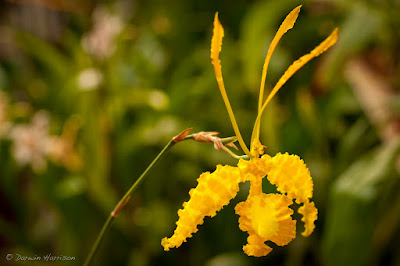Psychopsis sanderae is native to Peru. These plants were found again in the Junin Department. They grew high on trunks and on large branches of trees in damp mountain forests at elevations most likely around 1220 meters...
Psychopsis sanderae also called as Sander's Psychopsis, Oncidium sanderae, is a species of the genus Psychopsis. This species was described by Emil Lückel & Guido Jozef Braem in 1982.
IDENTIFY PSYCHOPSIS SANDERAE
Psychopsis sanderae is native to Peru. These plants were found again in the Junin Department. They grew high on trunks and on large branches of trees in damp mountain forests at elevations most likely around 1220 meters.
It is a small sized, warm to cool growing, caespitose epiphyte, which reaching a height of 15.5-24.5 cm, with ovate or ovate-elliptic, complantae, wrinkled, 3.6-4.6 cm long and 3.0-3.8 cm wide pseudobulbs with a single, apical narrowly oblong-lanceolate, acute, coriaceous leaf with a conduplicate petiolate, 12-20 cm long base.
Sander's Psychopsis blooms on an erect, 28 cm long, single successively flowered inflorescence subtended by tubular, scarious bracts arising on a mature pseudobulb occurring in the spring. The flowers are 13-15 cm high and about 5 cm wide. The ends of the inner whorl flakes and the dorsal petal are dark reddish-brown, and their color pales to light brown at 1/4 of the length at the base. The side petals of the external whorl are bright, pale yellow, with relatively small red-brown spots. The lip is shiny, greenish-yellow, with numerous small, sharp red dots and spots around the center plot. The thickening at the stump is matte-white with hazel patches. The dark, purple-brown stump has brown, frayed, wing-like wings with dark-brown glandular ends. The pollen chamber cover is pale yellowish-green with a dark brownish-purple end separated by a wide yellowish-green strip.
PSYCHOPSIS SANDERAE CARE AND CULTURE
Cultural information should only be used as a guide, and should be to be adapted to suit you. Your physical location; where you grow your plants, how much time you have to devote to their care, and many other factors, will need to be taken into account. Only then can you decide on the cultural methods that best suit you and your plants.
Light:
Psychopsis sanderae needs a light level of 18000-25000 lux. The plants can tolerate higher levels of light intensity provided that high humidity and intense air movement are ensured.
Temperature:
It is a thermophilic plant. Throughout the year, the average day temperature is 26-28 ° C, and the average night temperature is 14-15 ° C, with a daily amplitude of 11-14 ° C.
Humidity:
Sander's Psychopsis needs the humidity of 75-80% throughout the year.
Substrate, growing media and repotting:
Psychopsis sanderae grow well attached to pieces of tree ferns or cork, as long as we can provide them with high humidity, but during the summer it requires daily watering. In the period of extremely hot and dry weather, attached plants may require even several waterings during the day.
They can also be grow in flat pots or baskets. In this case, they use a substrate quickly draining excess water, which, however, contains substances that retain a certain amount - such as chopped sphagnum moss or perlite. Wood charcoal is also often added to ensure the air permeability of the substrate and to prevent acidification. Usually, relatively small pots are used that only allow the roots to be accommodated.
The plants should be repotted only when it is necessary, and only when new roots appear that allow the plant to return to its normal state in the shortest possible time. Like other species of this genus, these plants should grow well in wire baskets lined with coconut fiber and then filled with a mixture of fine to medium pieces of tree fern fiber with the addition of about 10% perlite and 10% charcoal.
Watering:
Rainfall is abundant throughout the year. The cultivated plants should be watered frequently, but their roots must quickly dry after watering, and the substrate should never be soggy or spread.
Fertilizer:
During the active growth, the plants should be fertilized every week 1/4-1/2 of the recommended dose of fertilizer for orchids. You can use sustainable fertilizer throughout the year. If the plants are grown at latitudes where the light level and temperature are lower, in the absence of active growth, the fertilization should be reduced in order to prevent the accumulation of mineral salts in the substrate.
Rest period:
In winter, the amount of water should be slightly reduced, especially if Psychopsis sanderae are grown under dark, short days, which occurs at moderate latitudes. However, they should not dry up completely, especially for a longer period. If the amount of water supplied decreases, the fertilization should also be reduced until resumption of stronger spring watering.















COMMENTS